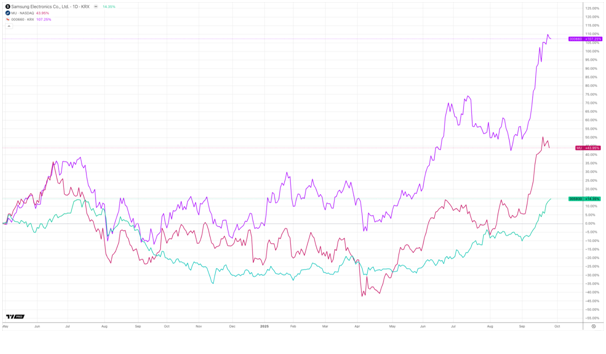So far, the HBM market is dominated by SK hynix with a share of about 62%, Micron holds the second place with 21%, and Samsung takes the third place with 17%. However, according to statistics and the position of companies, the balance may change as early as 2025-2026. Micron claims record HBM4 speeds and nearly sold-out production for 2026, while Samsung, having exceeded the 30% mark thanks to contracts with Nvidia, only plans to increase market share dramatically.

In recent months, the movements of the S&P 500 index and S&P 500 futures have shown a growing correlation with news from the semiconductor sector. For example, Nvidia has become a symbol of the AI rally, but its success directly depends on the memory providers. Major players understand that memory is not just a component, but a critical factor in determining the scalability of AI infrastructure. Even small investors and ordinary observers understand that every statement by Samsung, SK hynix, or Micron about HBM4 is instantly translated into stock price movements.
Micron’s financial statements reflect the general trend. Revenue growth of 46% year-over-year to $11.3 billion, and a net profit that tripled to $3.2 billion, speak volumes. Investors tracking the earnings calendar today would note Micron’s report as a key highlight, signaling both technological strength and financial discipline. The company emphasizes that it does not intend to sacrifice profitability for market share. Micron positions itself as both a technology innovator and a financially disciplined player, which appeals to investors. This, in turn, strengthens interest in its securities amid high demand for AI infrastructure.
Samsung is still playing catch-up, but HBM4 can make a difference and elevate the company. According to its statements, energy efficiency is expected to increase by 40% and transmission speeds reaching up to 11 Gbit/s. In combination with contracts with Nvidia, this results in market share growth exceeding 30%. For the market, such a reversal could add additional weight to Samsung from a global perspective, as well as strengthen the South Korean giant’s position in the broader AI rally.
SK hynix, in turn, still retains the leading market share, but its position no longer look as confident. If Samsung and Micron successfully implement HBM4 projects, SK hynix’s advantage will gradually decrease. This suggests a possible reassessment of the risks in the company’s securities and a more volatile profitability profile.
Nvidia has long been the prominent key element of the entire chain. The company dictates the requirements for the volume and characteristics of HBM, and suppliers actually build strategies around its requirements. From a market perspective, this turns Nvidia into a central hub in the global AI cycle. The growth of its capitalization inevitably affects the shares of its partners, while their success in turn affects the value of Nvidia itself.
The shift toward HBM4 and HBM4E is occurring against the background of declining DDR4 production and the growing demand for NAND. This represents a structural shift in an industry where memory is becoming a strategic resource for AI, whose influence on market dynamics will only increase, and competition for HBM4 sets the direction for the entire technology sector.
The race between Samsung, SK hynix, and Micron is both a technological and a financial story. On one hand, companies compete in memory speed and energy efficiency. On the other hand, their successes are directly reflected in stock prices and set the tone for the broader tech rally. In this sense, the HBM4 market is becoming an indicator of technological progress and the dynamics of global indices.

